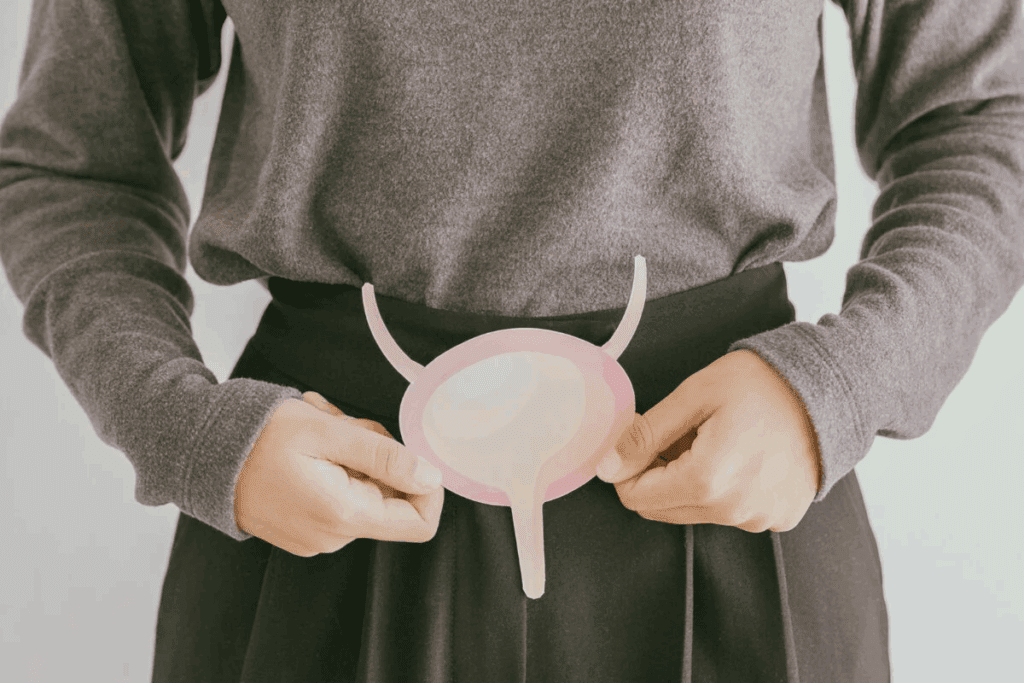Last Updated on November 25, 2025 by Ugurkan Demir

Chemotherapy is key in treating bladder cancer. It helps with both non-muscle-invasive and muscle-invasive types. It’s also used for cases where the cancer has spread. At Liv Hospital, we aim to offer top-notch care and new health solutions.
In the United States, about 84,000 people get bladder cancer each year. It’s the sixth most common cancer. This makes chemotherapy very important. We make our chemotherapy plans to help our patients live better and longer.
Discover 7 key facts about chemo treatment for bladder cancer. Learn side effects, process, and effectiveness.

Bladder cancer is a complex condition that needs a deep understanding of its types and stages. This knowledge helps choose the best treatment. The disease’s classification is key in deciding the treatment path.
Bladder cancer is divided into two main types: non-muscle-invasive bladder cancer (NMIBC) and muscle-invasive bladder cancer (MIBC). NMIBC stays in the bladder’s inner lining. MIBC invades the muscle layer, making it more aggressive and serious.
The staging of bladder cancer is also important. It ranges from stage I, where cancer is in the bladder’s inner lining, to stage IV, where it has spread to distant parts of the body. Knowing the stage helps in choosing the right treatment.
Treatment for bladder cancer includes surgery, chemotherapy, and immunotherapy. The choice depends on the cancer type and stage, and the patient’s health.
Surgery is often the first treatment, from TURBT for early cancers to radical cystectomy for advanced cases. Chemotherapy may be used before or after surgery to kill cancer cells. Immunotherapy boosts the body’s immune system to fight cancer, mainly for advanced cases.
It’s important for patients to understand these treatments. We will explore chemotherapy for bladder cancer further, including its role, drugs, and side effects.

Chemotherapy is a key part of treating bladder cancer. It depends on the cancer’s stage and type. We use it in different ways to fight bladder cancer, based on how far it has spread and the patient’s health.
Chemotherapy is suggested for bladder cancer patients in certain situations. For non-muscle-invasive bladder cancer, we use it inside the bladder. This directly targets the cancer.
In cases of muscle-invasive bladder cancer, chemotherapy is part of a bigger treatment plan. This plan might also include surgery and radiation.
For metastatic bladder cancer, chemotherapy helps control the disease’s spread. It also eases symptoms and improves life quality. The choice to use chemotherapy depends on the cancer’s stage, the patient’s health, and their wishes.
The goals of chemotherapy change with the cancer’s stage. In early stages, it aims to prevent recurrence or reduce the risk of progression. For more advanced stages, it tries to control symptoms, shrink tumors, or slow disease progression.
In neoadjuvant chemotherapy, we aim to shrink tumors before surgery. This makes them easier to remove. Adjuvant chemotherapy is used after surgery. It kills any remaining cancer cells to lower the chance of it coming back.
It’s important for patients to understand chemotherapy’s role in bladder cancer treatment. By talking with their healthcare team, they can create a treatment plan that fits their needs and situation.
Chemotherapy is key in treating bladder cancer. It’s important for patients and caregivers to know about the drugs used. These drugs target cancer cells and can be used alone or together.
Single-agent chemotherapy uses one drug to fight bladder cancer. Some common drugs include:
These drugs target fast-growing cancer cells. They help slow or stop tumor growth.
Combination chemotherapy uses several drugs together. This method can be more effective than using one drug. Common combinations include:
Combination chemotherapy can lead to better results and outcomes for advanced bladder cancer patients.
Knowing about different chemotherapy drugs and regimens helps in making treatment decisions. It’s vital to discuss the benefits and side effects of each option. This ensures the best treatment plan for each patient.
Chemotherapy for bladder cancer comes in many forms. Each has its own benefits and things to think about. The method chosen depends on the cancer’s stage, type, and the patient’s health.
Systemic intravenous chemotherapy puts drugs directly into the blood through a vein. It’s good for cancer that has spread. Medical Expert, a renowned oncologist, says it’s key for advanced bladder cancer.
It involves getting infusions over time. Side effects like tiredness, nausea, and hair loss can happen. But, they’re usually short-lived and can be managed.
Intravesical chemotherapy puts drugs right into the bladder. It’s used for early cancer or to stop it from coming back. It targets the bladder lining directly to lower cancer risk.
This method has fewer side effects because the drugs stay in the bladder. But, it can cause local side effects like bladder irritation or needing to urinate more often.
Neoadjuvant chemotherapy is given before surgery to make tumors smaller. Adjuvant chemotherapy is after surgery to kill any cancer cells left. This reduces the chance of cancer coming back.
The
“National Comprehensive Cancer Network (NCCN), says neoadjuvant chemotherapy can help patients with muscle-invasive bladder cancer live longer.”
Using both neoadjuvant and adjuvant chemotherapy shows the value of treating bladder cancer in many ways.
In summary, choosing how to give chemotherapy for bladder cancer is complex. Knowing the different methods helps patients and doctors decide the best treatment.
Chemotherapy for bladder cancer can last from a few weeks to months. It’s important for patients to know how long treatment will take. This helps them prepare physically and emotionally.
Chemotherapy for bladder cancer can last from a few weeks to months. The exact time depends on the cancer’s stage, the type of chemotherapy, and how well the patient responds. Some patients get chemotherapy in cycles, with breaks in between to recover.
Several things can change how long chemotherapy lasts for bladder cancer. These include:
For example, patients getting neoadjuvant chemotherapy (chemo before surgery) might have shorter treatment. This is different from those getting adjuvant chemotherapy (chemo after surgery).
Knowing these factors helps plan the best treatment schedule. This ensures the best results for patients.
Managing side effects is key when you’re getting chemotherapy for bladder cancer. Chemotherapy is effective but can cause side effects that affect your life quality.
Chemotherapy for bladder cancer can cause nausea, fatigue, hair loss, and an increased risk of infection. This happens because chemotherapy targets fast-growing cells. It hits both cancer cells and some healthy cells.
Some common side effects include:
Knowing these side effects helps patients get ready and manage them better.
Managing chemotherapy side effects is key to keeping your quality of life up. We suggest several ways to handle common side effects:
| Side Effect | Management Strategy |
| Nausea and Vomiting | Anti-nausea medication, dietary changes (e.g., eating small, frequent meals) |
| Fatigue | Rest, gentle exercise (e.g., walking), energy conservation techniques |
| Hair Loss | Scalp cooling, gentle hair care, wigs or headscarves |
| Increased Risk of Infections | Good hygiene practices, avoiding crowds, prophylactic antibiotics (if recommended) |
Using these strategies, patients can manage their side effects better. This improves their treatment experience.
It’s vital for patients to work with their healthcare team to create a plan for managing side effects. This team effort ensures patients get the support they need during treatment.
Chemotherapy is a key treatment for bladder cancer. Its success depends on the cancer’s stage. We’ll look at how well chemotherapy works for bladder cancer, focusing on different stages and what affects treatment success.
Chemotherapy’s success in treating bladder cancer depends on the cancer’s stage. For early-stage bladder cancer, chemotherapy can shrink tumors and prevent them from coming back. In more advanced stages, chemotherapy aims to control the disease, ease symptoms, and improve life quality.
Research shows that how well chemotherapy works varies by bladder cancer stage:
Many factors affect how well chemotherapy works for bladder cancer. Knowing these factors is key to better treatment results.
By considering these factors and customizing chemotherapy, doctors can make treatments more effective. This helps improve patient outcomes.
Recent research has greatly improved chemotherapy for bladder cancer patients. We’re seeing big changes in how chemotherapy is given and how well it works.
New drug delivery systems are a big step forward. They aim to make chemotherapy more effective and reduce side effects. For example, nanoparticle-based drug delivery targets cancer cells better, protecting healthy tissues.
Intravesical chemotherapy delivers drugs directly to the bladder. It’s shown to lower the risk of cancer coming back in non-muscle-invasive cases.
Researchers are also looking into combining chemotherapy with other treatments. This includes immunotherapy, which could improve results for bladder cancer patients.
Clinical trials are testing different combinations, like chemotherapy with targeted therapies. These new methods aim to beat chemotherapy resistance and better patient outcomes.
As research keeps moving forward, we’ll see even more new ways to treat bladder cancer with chemotherapy. These advancements are promising for better patient results and quality of life.
Getting ready for chemotherapy is key for bladder cancer patients. It helps them know what to expect and how to handle treatment well. We’ll cover important points to think about before and during treatment.
It’s vital to understand your treatment plan before starting. Talk to your healthcare provider about:
Pre-treatment preparations might include:
While on chemotherapy, keep a close eye on your health. Common side effects are fatigue, nausea, and hair loss. Here’s what to do:
Regular check-ups with your healthcare provider are important. They help check how you’re doing and fix any problems quickly.
Chemotherapy is key in treating bladder cancer. It offers many options based on each patient’s needs. We’ve looked at how it works, the drugs used, how it’s given, and how long it lasts.
At Liv Hospital, we give top-notch care to bladder cancer patients. We make sure each person gets treatment that fits them best. Our team uses the newest research to help patients get better.
To sum up, chemotherapy is a big part of fighting bladder cancer. Research keeps looking for ways to make it even better. For more on bladder cancer treatment and chemotherapy, talk to our skilled doctors.
Chemotherapy is key in treating bladder cancer, mainly in advanced stages. It kills cancer cells and slows their growth. It also helps relieve symptoms.
Drugs like cisplatin, gemcitabine, and methotrexate are common for bladder cancer. We often mix them to boost their effect.
Chemotherapy can be given in different ways. It can be through intravenous treatment or directly into the bladder.
Treatment length varies based on the disease stage and patient health. It can last from weeks to months.
Side effects include nausea, fatigue, hair loss, and infection risk. We help manage these to improve life quality.
Chemotherapy can cure some cases, often when combined with surgery. Its success depends on the cancer type and stage.
Neoadjuvant chemotherapy is given before surgery to shrink tumors. It makes surgery easier and can improve outcomes for muscle-invasive cancer.
Intravesical chemotherapy involves putting drugs directly into the bladder. It’s used for non-muscle-invasive cancer to lower recurrence risk.
Chemotherapy is used for metastatic bladder cancer. Its success depends on the patient’s health and disease extent. We tailor treatments for each patient.
Research aims to create new drugs and improve delivery methods. It also explores combining treatments to better outcomes for bladder cancer patients.
National Center for Biotechnology Information. (2025). 7 Key Facts About Chemo Treatment for Bladder.
Subscribe to our e-newsletter to stay informed about the latest innovations in the world of health and exclusive offers!